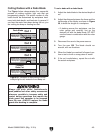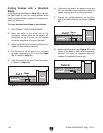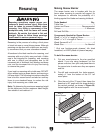
-46-
Model G0690/G0691 (Mfg. 11/10+)
Workpiece
Fence
Blade
Figure 67. Second cut to create a rabbet.
6. Reconnect the saw to the power source, then
perform the cut.
7. Lay the workpiece flat on the table, as shown
in Figure 67, adjust the saw blade height to
intersect with the first cut, then perform the
second cut to complete the rabbet.
A ripping blade is typically the best blade to use
for cutting rabbets when using a standard blade
because it removes sawdust very efficiently. (See
Page 34 for blade details.) Also, a sacrificial fence
is not required when cutting rabbets with a stan-
dard blade.
To cut rabbets with the standard blade:
1. DISCONNECT SAW FROM POWER!
2. Ensure that the riving knife and standard
table insert are installed.
3. Mark the width of the rabbet cut on the edge
of the workpiece, so you can clearly identify
the intended cut while it is laying flat on the
saw table.
4. Raise the blade up to the desired depth of cut
(depth of rabbet channel desired).
5. Stand the workpiece on edge, as shown in
Figure 66, then adjust the fence so the blade
is aligned with the inside of your rabbet chan-
nel.
Cutting Rabbets with a Standard
Blade
Fence
Blade
Workpiece
Figure 66. Rabbet cutting with a standard blade.
— If the workpiece is very tall, or is unstable
when placed against the fence, lay it flat on
the table and use a dado blade to perform
the rabbet cut.
DO NOT place a tall board on edge to per-
form a rabbet cut with a standard blade.
Workpieces that are too tall to properly
support with the fence can easily shift dur-
ing operation and cause kickback. Instead,
place the stock flat on the saw and perform
the rabbet cut with a dado blade, as instruct-
ed on Page 45.
15
30
45


















